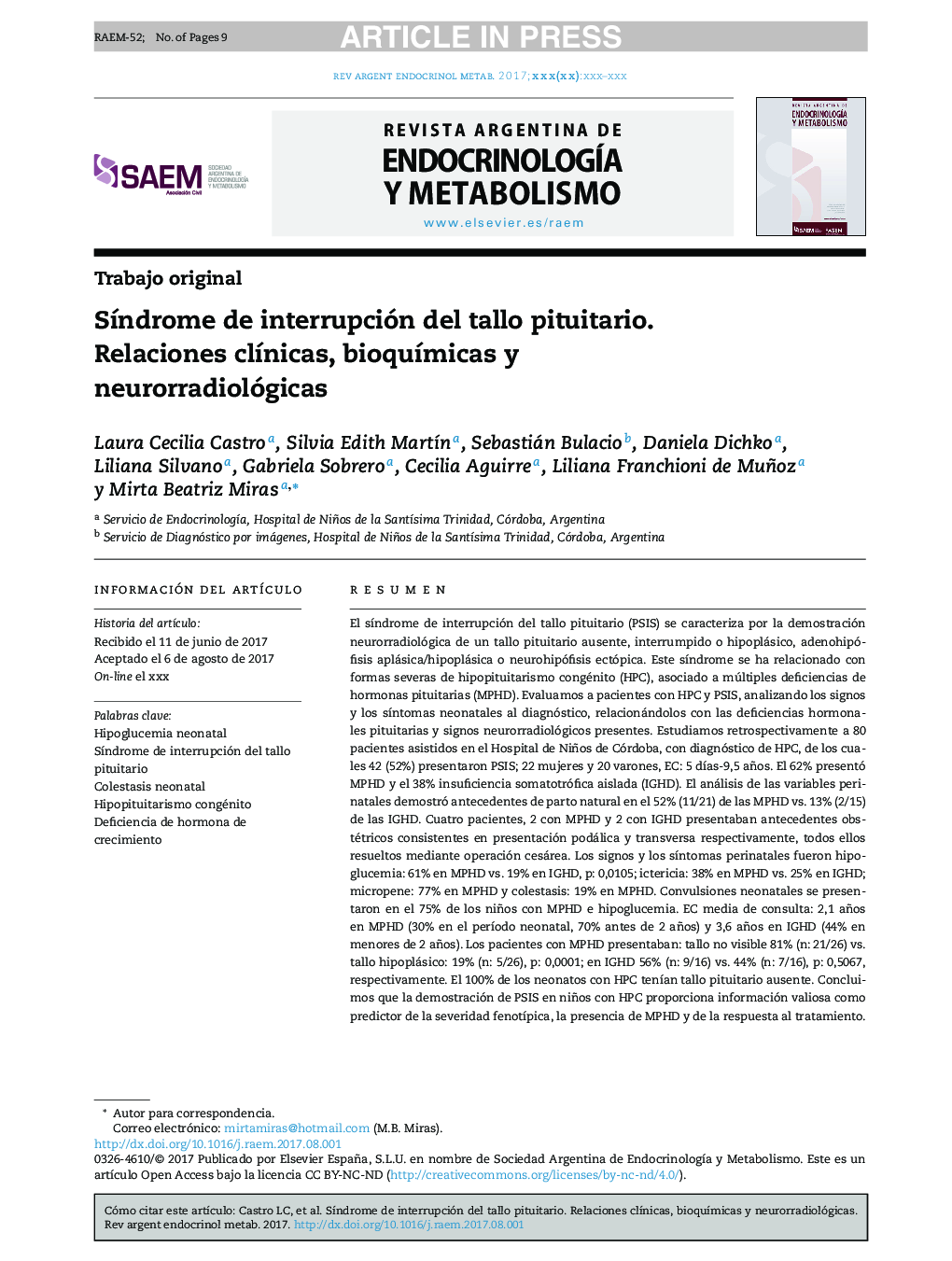| کد مقاله | کد نشریه | سال انتشار | مقاله انگلیسی | نسخه تمام متن |
|---|---|---|---|---|
| 8724406 | 1589709 | 2017 | 9 صفحه PDF | دانلود رایگان |
عنوان انگلیسی مقاله ISI
SÃndrome de interrupción del tallo pituitario. Relaciones clÃnicas, bioquÃmicas y neurorradiológicas
دانلود مقاله + سفارش ترجمه
دانلود مقاله ISI انگلیسی
رایگان برای ایرانیان
کلمات کلیدی
موضوعات مرتبط
علوم پزشکی و سلامت
پزشکی و دندانپزشکی
غدد درون ریز، دیابت و متابولیسم
پیش نمایش صفحه اول مقاله

چکیده انگلیسی
Pituitary stalk interruption syndrome (PSIS) is characterised by the combination of an interrupted or thin pituitary stalk, absent or ectopic posterior pituitary, and anterior pituitary hypoplasia. It is manifested as isolated (IGHD) or combined pituitary hormone deficiencies (CPHD) of variable degrees and timing of onset, with a wide spectrum of clinical phenotypes. PSIS may be an isolated morphological abnormality or be part of a syndrome. A retrospective evaluation is presented of clinical signs and symptoms present at early life stages, as well as an analysis of their relationship with hormone laboratory tests and diagnostic imaging in children with congenital hypopituitarism (CHP), and PSIS. This study was performed in a single centre on a sample of 42 children out of a total of 80 CHP patients, with a chronological age range between 5 days and 9.5 years from a database analysed over a period of 26 years. The study included 26/42 (62%) with CPHD and 16/42 (38%) with IGHD. The analysis of perinatal variables showed a natural delivery in 52% (11/21) of CPHD vs 13% (2/15) of IGHD. Four patients, two with CPHD and two IGHD had breech and transverse presentation respectively. All of them were resolved by caesarean section. The perinatal histories showed hypoglycaemia (61% CPHD vs 19% IGHD, P=.0105), jaundice (38% CPHDvs25% IGHD), micropenis (75%CPHD), hypoglycaemic seizures (75% CPHD), and cholestasis (19% CPHD). The mean CA of consulting for CPHD patients was 2.1 years, 30% in neonatal period and 70% before 2 years. The mean chronical age (CA) was 3.6 years in IGHD patients, with 44% of them less than 2 years. MRI showed that 81% of CPHD patients had absence of pituitary stalk vs 19% with thin pituitary stalk (P=.0001); Patients with IGHD presented 56% absence of pituitary stalk vs 44% with thin pituitary stalk (P=.5067). All (100%) of the patients diagnosed in the neonatal stage had absent pituitary stalk. The characterisation of GH deficient patients by presence and type of hypothalamic-pituitary imaging abnormality provides valuable information as a predictor of phenotypic severity, treatment response, and the potential to develop additional hormonal deficiencies. We conclude that demonstrating PSIS in children with HPC provides valuable information as a predictor of phenotypic severity, presence of MPHD, and response to treatment. The low frequency of potentially dysfunctional positional obstetric history, as part of the pathophysiological mechanisms responsible for PSIS, would indicate the need to analyse the importance of possible genetic and epigenetic factors involved. Early diagnosis of HPC should be suspected in the presence of clinical signs and symptoms, such as hypoglycaemia, cholestasis, micropenis, and associated facial midline defects. MRI should be part of complementary studies in patients with this diagnostic suspicion, especially at an early age. Late recognition of this entity may increase morbidity and mortality with potential permanent deleterious effects.
ناشر
Database: Elsevier - ScienceDirect (ساینس دایرکت)
Journal: Revista Argentina de EndocrinologÃa y Metabolismo - Volume 54, Issue 4, OctoberâDecember 2017, Pages 151-159
Journal: Revista Argentina de EndocrinologÃa y Metabolismo - Volume 54, Issue 4, OctoberâDecember 2017, Pages 151-159
نویسندگان
Laura Cecilia Castro, Silvia Edith MartÃn, Sebastián Bulacio, Daniela Dichko, Liliana Silvano, Gabriela Sobrero, Cecilia Aguirre, Liliana Franchioni de Muñoz, Mirta Beatriz Miras,